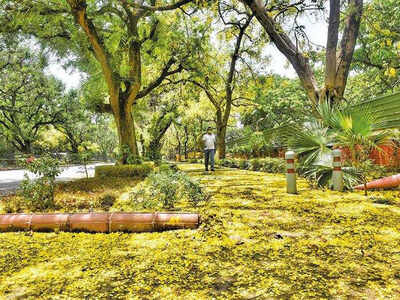Top Searches
- News
- City News
- delhi News
- City of gold: Bright spots amid the despondency
City of gold: Bright spots amid the despondency

Amaltas, which lines the streets across Delhi, blossoms in late spring and its golden canopy is prominent from April to July.
NEW DELHI: Amid the gloom created by the Covid-19 pandemic, there is one aspect of the city that is bright and buoyant — the gold-lined streets. The Amaltas tree (Cassia fistula) is in bloom and its shower of dazzling yellow flowers has the power to lift dampened spirits. A middle-sized deciduous and mostly ornamental tree, it bursts into blossoms in late spring and its golden canopy is prominent from April to July.
Discarded initially by the British as an avenue tree owing to its nature of shedding leaves annually, the Amaltas today lines the streets across Delhi, including the Lutyens’ zone. Pradip Krishen, environmentalist and author of Trees of Delhi, revealed that the notion the tree was ‘introduced’ to Delhi or that it was brought here by the British are misconceptions. The golden shower, as it is sometimes called, grew in Delhi’s forests long before the colonialists claimed India.
“It is native to south-east Asia and commonly seen in this belt, including in Rajasthan or Haryana,” said Krishen, who added that the British had actually favoured species other than the Amaltas as avenue trees. “They wanted a tree that would not shed its leaves but stay green throughout the year,” the environmentalist said. “So, even if planted, it was put up in parks for its showy flowers, but never alongside an avenue. It was only in the 1960s and ’70s that they were used to line the streets and now it is a prominent feature of Delhi’s avenues.”
Referring to its unique seed dispersal, Krishen said that in 1920, British forestry expert Robert Scott Troup discovered that the tree relied on jackals and bears to carry its seeds far and near. Krishen said, “Unlike other leguminous trees, whose seed pods split open to scatter the seeds, the tubular Amaltas pod simply falls to the ground. Troup carried out an experiment, keeping some pods on open ground and some under a net. He found that animals such as jackals and bear were attracted to its scent and taste and swallowed the pod. Their digestive tracts weaken the outer layer of the pod and allow the seed to be excreted for germination.”
If the pods aren’t opened in this fashion, they simply decay over time. As Krishen disclosed, “Even today, to plant an Amaltas, the pod has to be first boiled to mimic the action of stomach acid weakening its outer layer. Only then can it be planted.”
Faiyaz Khudsar, scientist-in-charge, Yamuna Biodiversity Park, informed that the tree starts flowering before the monsoons arrive, showing signs of being under ‘stress’ to complete its life cycle. “The tree is native to the Aravali landscape and thrives in Delhi. It is also broad-leafed and not only looks beautiful, but can trap particulate matter, thus making it an ideal avenue tree,” said Khudsar.
Discarded initially by the British as an avenue tree owing to its nature of shedding leaves annually, the Amaltas today lines the streets across Delhi, including the Lutyens’ zone. Pradip Krishen, environmentalist and author of Trees of Delhi, revealed that the notion the tree was ‘introduced’ to Delhi or that it was brought here by the British are misconceptions. The golden shower, as it is sometimes called, grew in Delhi’s forests long before the colonialists claimed India.
“It is native to south-east Asia and commonly seen in this belt, including in Rajasthan or Haryana,” said Krishen, who added that the British had actually favoured species other than the Amaltas as avenue trees. “They wanted a tree that would not shed its leaves but stay green throughout the year,” the environmentalist said. “So, even if planted, it was put up in parks for its showy flowers, but never alongside an avenue. It was only in the 1960s and ’70s that they were used to line the streets and now it is a prominent feature of Delhi’s avenues.”
Referring to its unique seed dispersal, Krishen said that in 1920, British forestry expert Robert Scott Troup discovered that the tree relied on jackals and bears to carry its seeds far and near. Krishen said, “Unlike other leguminous trees, whose seed pods split open to scatter the seeds, the tubular Amaltas pod simply falls to the ground. Troup carried out an experiment, keeping some pods on open ground and some under a net. He found that animals such as jackals and bear were attracted to its scent and taste and swallowed the pod. Their digestive tracts weaken the outer layer of the pod and allow the seed to be excreted for germination.”
If the pods aren’t opened in this fashion, they simply decay over time. As Krishen disclosed, “Even today, to plant an Amaltas, the pod has to be first boiled to mimic the action of stomach acid weakening its outer layer. Only then can it be planted.”
Faiyaz Khudsar, scientist-in-charge, Yamuna Biodiversity Park, informed that the tree starts flowering before the monsoons arrive, showing signs of being under ‘stress’ to complete its life cycle. “The tree is native to the Aravali landscape and thrives in Delhi. It is also broad-leafed and not only looks beautiful, but can trap particulate matter, thus making it an ideal avenue tree,” said Khudsar.
FacebookTwitterLinkedinEMail
end of article
